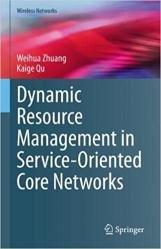Dynamic Resource Management in Service-Oriented Core Networks
- Добавил: literator
- Дата: 2-02-2022, 04:16
- Комментариев: 0
 Название: Dynamic Resource Management in Service-Oriented Core Networks
Название: Dynamic Resource Management in Service-Oriented Core NetworksАвтор: Weihua Zhuang, Kaige Qu
Издательство: Springer
Серия: Wireless Networks
Год: 2021
Страниц: 182
Язык: английский
Формат: pdf (true), epub
Размер: 34.1 MB
The service-oriented fifth-generation (5G) and beyond core networks are featured by customized network services with differentiated quality-of-service (QoS) requirements, which can be provisioned through network slicing enabled by the software-defined networking (SDN) and network function virtualization (NFV) paradigms. Multiple network services are embedded in a common physical infrastructure, generating service-customized network slices (also referred to as virtual networks). Each network slice supports a composite service via virtual network function (VNF) chaining, with dedicated packet processing functionality at each VNF. For a network slice with a target traffic load, the end-to-end (E2E) service delivery is enabled by VNF placement at NFV nodes (e.g., data centers and commodity servers) and traffic routing among corresponding NFV nodes, with static resource allocations. When data traffic actually enters the network, the traffic load is dynamic and can deviate from the target value, potentially leading to QoS performance degradation and network congestion. There are traffic dynamics in different time granularities. For example, the traffic statistics (e.g., mean and variance) can be non-stationary and can experience significant changes in a coarse time granularity, e.g., larger than 30 min, which are usually predictable. Within a long time duration with stationary traffic statistics, there are traffic dynamics in small timescales, e.g., less than 1 ms, which are usually highly bursty and unpredictable. To provide continuous QoS performance guarantee and ensure efficient and fair operation of the virtual networks over time, it is essential to develop dynamic resource management schemes for the embedded services experiencing traffic dynamics in different time granularities during virtual network operation.
This book provides a timely and comprehensive study of dynamic resource management for network slicing in service-oriented 5G and beyond core networks, from the perspective of developing efficient computing resource provisioning and scheduling solutions to guarantee consistent service performance in terms of E2E delay guarantee. Queueing theory is used in system modeling, and different techniques including optimization and machine learning are applied to solving the dynamic resource management problems. We capture the heterogeneity between computing and communication resources and investigate dynamic computing resource provisioning and scheduling for embedded delay-sensitive services. Based on a simplified M/M/1 queueing model with Poisson traffic arrivals, an optimization model for flow migration is developed to accommodate the large-timescale changes in the average traffic rates with average E2E delay guarantee while addressing a trade-off between load balancing and flow migration overhead. To overcome the limitations of Poisson traffic model, we develop a machine learning approach for dynamic VNF resource scaling and migration. The new solution captures the inherent traffic patterns in a real-world traffic trace with non-stationary traffic statistics in large timescale, predicts resource demands for VNF resource scaling, and triggers adaptive VNF migration decisions, to achieve load balancing, migration cost reduction, and resource overloading penalty suppression in the long run. Both supervised and unsupervised machine learning tools are investigated for dynamic resource management. To accommodate the traffic dynamics in small time granularities, we develop a dynamic VNF scheduling scheme to coordinate the scheduling among VNFs of multiple services, which achieves network utility maximization with delay guarantee for each service. Finally, after concluding remarks on the research work, we identify further research directions in the dynamic resource management.
Скачать Dynamic Resource Management in Service-Oriented Core Networks
[related-news] [/related-news]
Внимание
Уважаемый посетитель, Вы зашли на сайт как незарегистрированный пользователь.
Мы рекомендуем Вам зарегистрироваться либо войти на сайт под своим именем.
Уважаемый посетитель, Вы зашли на сайт как незарегистрированный пользователь.
Мы рекомендуем Вам зарегистрироваться либо войти на сайт под своим именем.
